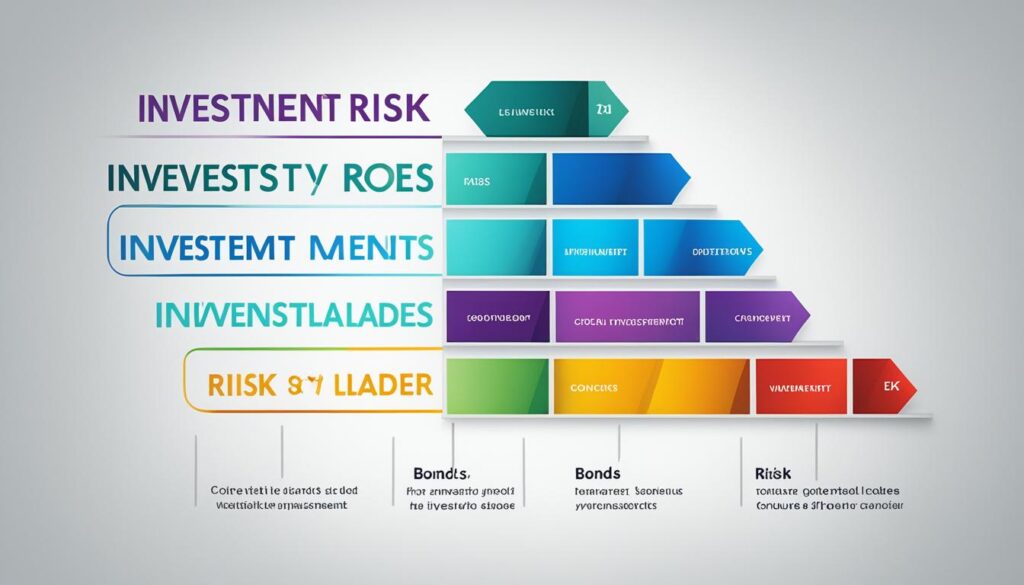
By 2028, the global alternatives market could hit a striking $24.5 trillion. This figure shows how important it is to look into different investment than just stocks and bonds. Anyone, whether seasoned or new to investing, can benefit from learning about various investment types. This knowledge helps you create a strong portfolio and understand the investment world better.
The realm of investments is broad and changes constantly, giving investors a variety of paths. You might choose the stability of cash or bonds, or seek growth in stocks. There’s also a chance to spread risk with alternative investments. Each one has its place on the risk-versus-reward ladder. To make the best decisions, it’s crucial to know the pros and cons of each investment type.
This article will take you into stocks, bonds, mutual funds, ETFs, and other alternatives. We’ll look at what makes each investment type unique and how to balance them for a strong portfolio. By the end, you’ll understand your investment options and the main things to consider when you’re investing. This understanding will help you start or enhance your investment approach.
Key Takeaways
- The investment landscape encompasses a wide range of asset classes, each with its own risk-return profile.
- Diversifying your portfolio across traditional and alternative investments can help mitigate market volatility and enhance overall returns.
- Understanding the investment risk ladder, from cash and bonds to stocks and alternative investments, is crucial for making informed decisions.
- Actively managed mutual funds may come with higher costs, while index-tracking ETFs can provide broad market exposure at lower fees.
- Alternative investments, such as hedge funds and private equity, offer the potential for higher returns but also carry higher risks and investment requirements.
Introduction to the Investment Landscape
The investment landscape is always changing and can seem overwhelming. There are many investment assets for beginners to consider. It’s important to know the main principles and different types of investments. This knowledge is key to long-term investment success.
Diversifying your investments means mixing different types. Stocks are pieces of a company that you can own. Bonds are more like loans, giving you interest payments. Mutual funds and Exchange-Traded Funds (ETFs) gather money from many people to buy various investments. Real estate can mean owning actual buildings or shares in real estate companies.
Alternative investments are expected to grow to $21.1 trillion by 2025, making up 15% of all money managed. The property market worldwide was worth about $7,239 billion in 2023, and it’s expected to reach $8,654 billion by 2032. Traditional investments have made up most portfolios, but more are looking at alternatives now.
The digital market for these alternative investments is booming, now worth over US$1 trillion. America saw a big jump in prices in late 2021 and early 2022. The standard bond investments fell in value by -14.6% over a year. In the ten years to September 30, 2022, the S&P 500 grew by 11.7% each year.
Having a well-diversified portfolio and a good financial plan is crucial. Just a small extra gain from managing investments actively can mean a lot more money in retirement. The benefit of good investment management can really change things over time.
Understanding the Investment Risk Ladder
Navigating investments is challenging but learning about the investment risk ladder helps. This ladder puts different types of investments in order of how risky they are. Cash is the safest, while alternative investments are often riskier.
At the bottom of the risk ladder are cash equivalents such as savings accounts. They have low risk and offer minimum returns. Next are fixed-income assets like bonds, which have more risk but also higher returns.
Stocks have the highest potential for returns but they are also much riskier. They sit at the top of the investment risk ladder. Many experts advise spreading your investments (diversifying) to lower risks.
| Asset Class | Risk Level | Potential Returns |
|---|---|---|
| Cash | Low | Low |
| Bonds | Moderate | Moderate |
| Stocks | High | High |
| Alternative Investments | Very High | Very High |
It’s important to understand the investment risk ladder for a balanced portfolio. Diversifying across different risk levels can help manage volatility in the market.

Bond Investments
Bond investments are key in the world of investing. They work like loans. A borrower, like a company or government, pays a set interest rate for using money. This interest is based on interest rates. Organizations use bonds to fund business, buy things, or do projects.
Bonds are usually less risky than stocks. But, they have their own set of risks. These include changes in how safe a bond is, its value, how easy it is to sell, and interest rate changes. It’s crucial for investors to know these risks to make smart choices.
Bond investors get a steady stream of income through regular interest payments. But, if interest rates go up, a bond’s value can drop. Because of this, bond investors need to think about the steady income they get versus the chance of losing their initial investment.
| Bond Type | Description | Risk Level |
|---|---|---|
| Government Bonds | Issued by national governments, often considered the safest type of bonds | Low |
| Corporate Bonds | Issued by private companies, with varying levels of credit risk | Medium to High |
| Municipal Bonds | Issued by state and local governments, often offering tax-advantaged income | Low to Medium |
If you’re thinking about investing in bonds, there are some things to keep in mind. Like your comfort with risk, the goals you have for your investments, and the risks tied to different bond types. Knowing the ins and outs of the bond market helps you make wise choices. This can help you manage the risks and rewards of your investment mix better.
Mutual Fund Investments
Mutual funds are a favorite pick for many investors. They help spread risk by combining money from lots of people. This money is then used to buy various assets such as stocks and bonds. Some funds are managed by pros, while others follow certain market indexes.
Investing in a mutual fund means you get instant diversity. This helps lower risk by spreading your money across many areas. It’s great for new investors or those without time to pick their own investments.
Exchange-traded funds (ETFs) have also become popular. They are like mutual funds but trade like stocks throughout the day. ETFs provide diversity and access to a mix of assets, often at a lower cost.
Choosing between mutual funds and ETFs offers lots of options. You can pick funds based on goals like growth or focus on specific sectors. Before investing, reading the fund’s prospectus is important. It tells you about strategies, costs, and past performance.
For both new and experienced investors, mutual funds and ETFs are key. They help you spread risk and aim for long-term financial goals. Picking the right funds after research is crucial.
In summary, mutual funds and ETFs are a smart way to join the market. There are many options, so you can invest in what matches your goals and comfort with risk. Understanding these investment tools helps you make smart choices for your future.
Exploring Different Types of Investments: Stocks, Bonds, and Beyond
Investing isn’t just about stocks and bonds. You can choose from many other types too. Stocks and bonds are still big parts of most investment plans. But there’s now a wide range of other options to consider.
Stocks are parts of companies you can buy. Their value changes with the company’s success and the economy. Bonds, however, are like loans you give to governments or companies. They pay interest regularly and you get your money back at the end. Bonds can pay interest twice a year, and U.S. savings bonds are considered one of the safest investments.
There’s more than just stocks and bonds to invest in. You could try real estate or digital currencies. Or you might look into commodities, private companies, or hedge funds. But, savvy investors should know the signs of fraud before investing in alternative investments, as the regulatory environment for these investments differs significantly from traditional investments.
Mixing traditional and alternative investments can be smart. It can help spread out risks and opportunities across different areas. Alternative investments aim to lower risks and bring stable earnings over time. They can be a bit riskier than stocks and bonds, but can also offer better rewards.
Yet, alternative investments bring their own challenges. They might not have clear prices, and finding out about what they’re made of can be tough. This can make it hard to see clearly into these investments.
Deciding what to invest in depends on your goals and how much risk you’re comfortable with. It’s important to know your options well. This helps in making choices that fit your financial plans closer.
In the end, there’s a lot to choose from in the world of investing. Knowing about the different types can help you reach your financial goals. It’s all about building a diverse portfolio that works for you.
Others also read this article : Beginner’s Guide to Stock Investing: How to Get Started
Stock Investments
Many people choose to invest in the stock market. This way, they can help companies grow and succeed. When you buy stocks, you own a piece of that company. You also get to have a say in what the company does.
The value of stocks depends on how well the companies are doing. If a company makes a lot of profit or creates something new, its stock price can go up. But if they have a tough year, the price of their stocks might fall.
Buying just one company’s stocks can be riskier. Yet, it might lead to bigger profits than safer options like bonds or keeping money in the bank. Still, stock prices can change quickly because of the news or the overall economy.
To lower the risk, experts suggest buying different stocks or funds. This method is called portfolio diversification. It can help protect your money and maybe make more over time.
| Investment Type | Potential for Returns | Risk Level |
|---|---|---|
| Stocks | High | High |
| Bonds | Moderate | Moderate |
| Cash Investments | Low | Low |
Learning about stock investments is key. With knowledge, investors can make smart choices and reach their financial dreams. It’s important to look deeply at companies and the economic conditions. This assures your investments match your goals and how much risk you’re okay with.
Alternative Investments
The world of investing is much bigger than just stocks, bonds, and cash. There are other options called alternative investments. This includes things like real estate, hedge funds, private equity, commodities, and cryptocurrencies. They can be riskier but could also give better returns and help spread out risk in your investments.
Adding these alternative options to your investments can lower the risk from the ups and downs of the stock and bond markets. Because they act differently, they can make your investments less likely to all move together, reducing risk.
| Alternative Investment | Key Features |
|---|---|
| Real Estate | Provides potential for current income from rent and capital appreciation. Includes both residential and commercial properties. |
| Hedge Funds | Employ a variety of investment strategies to generate returns, often with higher risk and higher fees compared to traditional investments. |
| Private Equity | Invests directly in private companies, offering opportunities for growth and turnaround situations. May require high minimum investments. |
| Commodities | Physical goods like gold, oil, or agricultural products that can serve as a hedge against inflation and economic uncertainty. |
| Cryptocurrencies | Digital assets that have gained significant attention for their potential capital appreciation, though with high volatility. |
However, these kinds of investments are not for everyone. You need to know a lot about them, have a lot of money, and they’re not as closely watched by the government. This makes them more for big-time investors and people with a lot of money. Before jumping in, it’s really important to understand the risks, costs, and if they fit with your investment plan and how much risk you’re okay with.
By smartly using alternative investments alongside more traditional ones, you might improve how well your investments do and lessen the risk. This could help you meet your financial goals better over the long term.
Investing Sensibly, Suitably, and Simply
Investing wisely means keeping it simple and fitting for you. Many skilled investors spread their money into various types of assets. They pick these based on how much risk they are willing to take. Starting with basic choices like mutual funds is a good idea.
If you are too busy or lack investment knowledge, index funds might be best. They match the market, so you don’t have to pick individual stocks. Plus, they often cost less than other funds.
Other investors might change what they invest in based on what the economy is doing. This more active approach needs a good understanding of the market. They must be careful not to let their feelings guide their choices.
However you choose to invest, the goal is the same: building a mix of investments that suits your comfort with risk and your financial aims. By keeping your investment strategy simple and smart, you can move toward your financial goals.
Why do most investors do worse than the market? They let emotions guide their investment decisions. This leads them to think they are doing better than they really are. It shows how our emotions can steer us wrong.
It suggests setting clear goals and making a solid financial plan before investing. This is because many people don’t have the right skills or tools to manage investments well on their own. They often end up with less money than they could have had.
Most people buy things when they feel good about it, even if it’s pricey. They might sell when things look bad. This shows it’s a good idea to get advice from professionals. They can help you make choices that are in your best interest over time.
A lot of people who invest by themselves focus only on their portfolio. They don’t consider their big life goals enough. Making and keeping a balanced portfolio can be hard without the right knowledge and help. It’s important to think about more than just how your investments are doing.
Asset Class Expectations and Economic Conditions
Stocks and bonds usually do the opposite based on the economy’s health. In good times, stocks do well since people buy more and companies make more money. But then, bond values can drop due to higher interest and lower prices. But when the economy falters, stocks don’t do as well. However, bonds can shine because interest rates fall and their prices rise.
On the flip side, real estate and commodities react differently to the economy. Real estate can do very well in a strong economy. This is because people have more money, feel good, and want to buy homes and offices. Yet, things like gold can become more valuable during tough times. This is because they work as protection when inflation and economic troubles hit.
It’s key for investors to know how these economic swings affect various investments. This way, they can pick better when it comes to what to invest in. By matching their choices with the expected state of the economy, investors can lower their risks and make their investments stronger against tough times.
| Asset Class | Economic Conditions | Performance Expectations |
|---|---|---|
| Stocks | Strong Economic Growth | Outperform |
| Stocks | Economic Downturn/Recession | Underperform |
| Bonds | Strong Economic Growth | Underperform |
| Bonds | Economic Downturn/Recession | Outperform |
| Real Estate | Strong Economic Growth | Outperform |
| Commodities (e.g., Gold) | Economic Uncertainty/Inflation | Outperform |
Using smart, data-based insights helps investors understand the flow between different assets and economic trends. Armed with this knowledge, they can steer through investments better, lower risks, and possibly see better long-term results for their portfolios. This approach can make their asset class performance and portfolio management strategies more effective.
Diversification Strategies
Diversification is more than just spreading risk. It’s about mixing different assets to balance risk and reward. By spreading your money across stocks, bonds, real estate, and more, you lessen the chance of big losses all at once. This mix can also boost your overall gains over time.
When you diversify well, you invest in a variety of things. This includes various types of investments and from different places. Doing this well can lower your risks and might help you earn more in the long run. Here are some smart ways to diversify:
- Asset Allocation: Spread your investments across different types, like stocks and bonds, to balance risk and reward.
- Sector Diversification: Invest in many industries to avoid relying too heavily on just one, lowering certain risks.
- Market Capitalization Diversification: Hold stocks of different sizes to benefit from their various growth potentials.
- Growth and Value Diversification: Invest in both types of stocks to cover your bases in the market.
- Geographic Diversification: Put money in both domestic and international markets to avoid risks tied to a single country.
Following these spreading-out strategies helps you make a strong portfolio. It might reduce how much your investments jump up and down, making your money more steady. Yet, remember that while diversification is smart, it doesn’t promise profits or save you from all losses. And, its results depend on what the market is like and what you want from your investments.
With today’s investment world being so complex, diversification is a must. It helps you protect your money, possibly make more, and meet your future financial goals. By putting your money in different places and in different ways, you not only lower risks but also increase your chances of reaching your financial dreams.
Conclusion
The world of investing goes beyond just stocks, bonds, and cash. If you learn about different investments’ risks and rewards, you can create a mix. This mix should fit your money goals and how much risk you can handle. By adding both common and rare investments, you can make your investment mix more varied. This helps deal with changes in the market over time.
Starting with easy investments or taking a more direct role can lead to building a strong mix. This mix can help you grow wealth and feel secure over time. Think about many kinds of investments, like stocks, bonds, mutual funds, ETFs, and other options. A full financial plan that meets your needs and likes can be made.
The secret to doing well in investing is keeping your mix varied and watching the market. Make choices based on how much risk you want to take and what you aim to achieve. Enjoying the mix of options in investing can set you up for a strong financial future.





